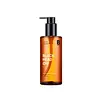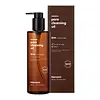What's inside
What's inside
 Key Ingredients
Key Ingredients

 Benefits
Benefits

 Concerns
Concerns

 Ingredients Side-by-side
Ingredients Side-by-side

Glycine Soja Oil
EmollientTriethylhexanoin
MaskingEthylhexyl Palmitate
EmollientPEG-20 Glyceryl Triisostearate
EmollientIsopropyl Myristate
EmollientIsohexadecane
EmollientEthylhexyl Stearate
EmollientPolyisobutene
Dicaprylyl Ether
EmollientIsononyl Isononanoate
EmollientCaprylic/Capric Triglyceride
Masking1,2-Hexanediol
Skin ConditioningCitrus Limon Peel Oil
MaskingCitrus Aurantium Dulcis Oil
MaskingCitrus Limon Fruit Oil
AstringentCymbopogon Schoenanthus Oil
MaskingGeranium Maculatum Oil
MaskingPentaerythrityl Tetra-Di-T-Butyl Hydroxyhydrocinnamate
AntioxidantCymbopogon Nardus Oil
MaskingCitrus Reticulata Leaf Oil
MaskingPrunus Armeniaca Kernel Oil
MaskingVetiveria Zizanoides Root Oil
MaskingMelaleuca Alternifolia Leaf Oil
AntioxidantMoringa Oleifera Seed Oil
EmollientWater
Skin ConditioningButylene Glycol
HumectantCentella Asiatica Extract
CleansingHouttuynia Cordata Extract
Skin ConditioningPentylene Glycol
Skin ConditioningEthylhexylglycerin
Skin ConditioningTocopherol
AntioxidantLimonene
PerfumingCitral
PerfumingGlycine Soja Oil, Triethylhexanoin, Ethylhexyl Palmitate, PEG-20 Glyceryl Triisostearate, Isopropyl Myristate, Isohexadecane, Ethylhexyl Stearate, Polyisobutene, Dicaprylyl Ether, Isononyl Isononanoate, Caprylic/Capric Triglyceride, 1,2-Hexanediol, Citrus Limon Peel Oil, Citrus Aurantium Dulcis Oil, Citrus Limon Fruit Oil, Cymbopogon Schoenanthus Oil, Geranium Maculatum Oil, Pentaerythrityl Tetra-Di-T-Butyl Hydroxyhydrocinnamate, Cymbopogon Nardus Oil, Citrus Reticulata Leaf Oil, Prunus Armeniaca Kernel Oil, Vetiveria Zizanoides Root Oil, Melaleuca Alternifolia Leaf Oil, Moringa Oleifera Seed Oil, Water, Butylene Glycol, Centella Asiatica Extract, Houttuynia Cordata Extract, Pentylene Glycol, Ethylhexylglycerin, Tocopherol, Limonene, Citral
Water
Skin ConditioningPEG-7 Glyceryl Cocoate
EmulsifyingDipropylene Glycol
HumectantEthylhexyl Palmitate
EmollientGlycerin
Humectant1,2-Hexanediol
Skin ConditioningDicaprylyl Ether
EmollientCoco-Caprylate/Caprate
EmollientHydroxyacetophenone
AntioxidantCitric Acid
BufferingLitsea Cubeba Fruit Oil
MaskingDisodium EDTA
Ethylhexylglycerin
Skin ConditioningButylene Glycol
HumectantCitrus Aurantium Dulcis Peel Oil
MaskingLavandula Angustifolia Oil
MaskingBetaine Salicylate
AntimicrobialSodium Citrate
BufferingSimmondsia Chinensis Seed Oil
EmollientPelargonium Graveolens Oil
MaskingCanarium Luzonicum Gum Nonvolatiles
MaskingRosmarinus Officinalis Leaf Oil
MaskingEucalyptus Globulus Leaf Oil
PerfumingCitrus Aurantium Amara Flower Oil
MaskingAnthemis Nobilis Flower Oil
MaskingEnantia Chlorantha Bark Extract
Skin ConditioningRhus Semialata Gall Extract
Skin ConditioningCamellia Japonica Flower Extract
EmollientChenopodium Quinoa Seed Extract
Skin ConditioningOenothera Biennis Flower Extract
AstringentUlmus Davidiana Root Extract
Skin ConditioningPinus Palustris Leaf Extract
TonicPueraria Lobata Root Extract
HumectantOleanolic Acid
Skin ConditioningOxygen
Skin ConditioningWater, PEG-7 Glyceryl Cocoate, Dipropylene Glycol, Ethylhexyl Palmitate, Glycerin, 1,2-Hexanediol, Dicaprylyl Ether, Coco-Caprylate/Caprate, Hydroxyacetophenone, Citric Acid, Litsea Cubeba Fruit Oil, Disodium EDTA, Ethylhexylglycerin, Butylene Glycol, Citrus Aurantium Dulcis Peel Oil, Lavandula Angustifolia Oil, Betaine Salicylate, Sodium Citrate, Simmondsia Chinensis Seed Oil, Pelargonium Graveolens Oil, Canarium Luzonicum Gum Nonvolatiles, Rosmarinus Officinalis Leaf Oil, Eucalyptus Globulus Leaf Oil, Citrus Aurantium Amara Flower Oil, Anthemis Nobilis Flower Oil, Enantia Chlorantha Bark Extract, Rhus Semialata Gall Extract, Camellia Japonica Flower Extract, Chenopodium Quinoa Seed Extract, Oenothera Biennis Flower Extract, Ulmus Davidiana Root Extract, Pinus Palustris Leaf Extract, Pueraria Lobata Root Extract, Oleanolic Acid, Oxygen
 Reviews
Reviews

Ingredients Explained
These ingredients are found in both products.
Ingredients higher up in an ingredient list are typically present in a larger amount.
1,2-Hexanediol is a synthetic liquid and another multi-functional powerhouse.
It is a:
- Humectant, drawing moisture into the skin
- Emollient, helping to soften skin
- Solvent, dispersing and stabilizing formulas
- Preservative booster, enhancing the antimicrobial activity of other preservatives
Butylene Glycol (or BG) is used within cosmetic products for a few different reasons:
Overall, Butylene Glycol is a safe and well-rounded ingredient that works well with other ingredients.
Though this ingredient works well with most skin types, some people with sensitive skin may experience a reaction such as allergic rashes, closed comedones, or itchiness.
Learn more about Butylene GlycolDicaprylyl Ether is created from caprylic acid. It is a texture-enhancer and emollient.
As an emollient, Dicaprylyl Ether is non-comedogenic. It helps soften and smooth the skin by creating a barrier on top. This barrier helps trap moisture in, helping to hydrate the skin.
Dicaprylyl Ether gives a non-greasy feel and better spreadability to products.
Learn more about Dicaprylyl EtherEthylhexyl Palmitate, also known as octyl palmitate, is created from 2-ethylhexyl alcohol and palmitic acid. It is a fatty acid ester.
The fatty acid content of Ethylhexyl Palmitate makes it an emollient. Emollients help soften and hydrate your skin by trapping moisture within.
Ethylhexyl Palmitate is also used to help improve the texture of cosmetics. It helps other ingredient dissolve in products and help disperse ingredients more evenly.
You'll likely find this ingredient in sunscreen, as it is often used to mix UV-blocking ingredients such as avobenzone and ethylhexyl triazone.
It can also help stabilize the fragrances in a product as a fragrance fixative.
Ethylhexyl Palmitate can be used to substitute mineral oil.
Due to its high fatty acid content, it may not be fungal-acne safe.
Learn more about Ethylhexyl PalmitateEthylhexylglycerin (we can't pronounce this either) is commonly used as a preservative and skin softener. It is derived from glyceryl.
You might see Ethylhexylglycerin often paired with other preservatives such as phenoxyethanol. Ethylhexylglycerin has been found to increase the effectiveness of these other preservatives.
Water. It's the most common cosmetic ingredient of all. You'll usually see it at the top of ingredient lists, meaning that it makes up the largest part of the product.
So why is it so popular? Water most often acts as a solvent - this means that it helps dissolve other ingredients into the formulation.
You'll also recognize water as that liquid we all need to stay alive. If you see this, drink a glass of water. Stay hydrated!
Learn more about Water